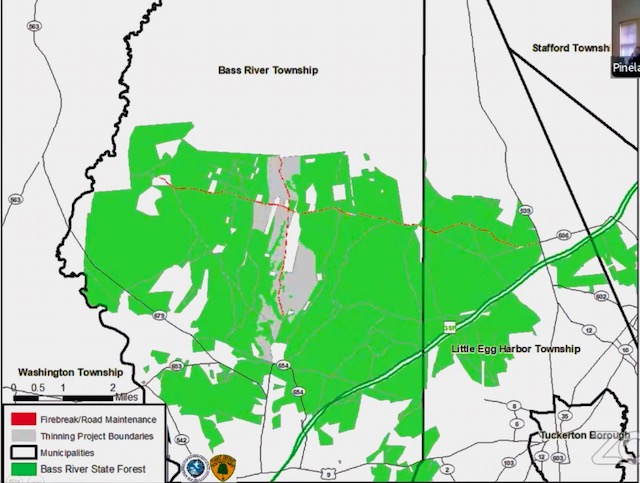“Forest Thinning” Is Wrong Chainsaw Medicine, Based On Flawed Science
This thinning was intended as a wildfire protection measure, yet we learned at the Pinelands Climate Committee last year that thinning has not proven to be a useful wildfire control measure; if anything, it causes wildfires to burn hotter and more destructively. Leslie Sauer shared a paper by ecologist Chad Hanson on this subject ( https://grist.org/fix/opinion/forest-thinning-logging-makes-wildfires-worse/ ) and argued persuasively that pro forestation is a much better approach to wildfire management. I find it difficult to support thinning as a wildfire management practice generally, but particularly so in this case. ~~~ Pinelands Commissioner Lohbauer
The Murphy DEP’s controversial Pinelands logging scheme purported to reduce wildfire risks is unnecessary, ecologically destructive, and will make wildfire risks worse.
There are 3 key points that are being ignored in the misleading spin and flawed science that DEP and their conservation group cheerleaders are using to defend their awful logging plan:
1) wildfire in the Pinelands is ecologically beneficial (read Emile DeVito of NJCF recent Op-Ed that he is now running away from:
“The Pine Barrens needs hot fires to persist, as do many of its rare species. The recent fire will ultimately benefit the ecosystem.”
2) there is little development (people and property) at risk in the forest that is targeted for 1,300 acres of “thinning” (cut & remove 2.4 million trees) and 13 miles of 50 foot wide clearcut “firebreaks”;
Both the firebreak and the thinning projects were proposed as wildfire control measures, yet—as Commissioner Doug Wallner pointed out on Friday—there is no population center, housing development, or commercial area near the sites of the project activity. Wallner, who spent his career at the National Park Service working with local agencies like the NJ Forest Service on wildfire control, argued that there was no reason to pursue these projects since there was no population at risk of wildfire harm that could be protected by this project. ~~~ Pinelands Commissioner Lohbauer
3) Scientific studies show that “forest thinning” is not effective in reducing wildfire risks and actually makes them worse (see also above Lohbauer comment).
Forest thinning is gaining more media attention and is heavily promoted by some land management agencies and logging interests, but science suggests the technique more often makes fires burn hotter and faster.
Hundreds of scientists and forest ecologists wrote a letter to President Biden warning about the flaws in traditional “thinning” approaches to wildfire management, see:
Logging conducted as commercial “thinning,” under the rubric of fire management, emits about three times more CO2 than wildfire alone. …
We have watched as one large wildfire after another has swept through tens of thousands of acres where commercial thinning had previously occurred due to extreme fire weather driven by climate change. Removing trees can alter a forest’s microclimate, and can often increase fire intensity. In contrast, forests protected from logging, and those with high carbon biomass and carbon storage, more often burn at equal or lower intensities when fires do occur.
See especially these studies in footnotes 10 and 11 in that letter:
|
10: (a) Bradley, C.M. C.T. Hanson, and D.A. DellaSala. 2016. Does increased forest protection correspond to higher fire severity in frequent-fire forests of the western USA? Ecosphere 7: article e01492; (b) Cruz, M.G., M.E. Alexander, and J.E. Dam. 2014. Using modeled surface and crown fire behavior characteristics to evaluate fuel treatment effectiveness: a caution. Forest Science 60: 1000-1004; (c) Cruz, M.G., M.E. Alexander, and P.A.M. Fernandes. 2008. Development of a model system to predict wildfire behavior in pine plantations. Australian Forestry 71: 113-121. |
| 11: (a) Zald, H.S.J., and C.J. Dunn. 2018. Severe fire weather and intensive forest management increase fire severity in a multi-ownership landscape. Ecological Applications 28: 1068-1080; (b) Odion, D.C., and C.T. Hanson. 2008. Fire severity in the Sierra Nevada revisited: conclusions robust to further analysis. Ecosystems 11: 12-15; (c) Odion, D. C., M. A. Moritz, and D. A. DellaSala. 2010. Alternative community states maintained by fire in the Klamath Mountains, USA. Journal of Ecology 98: 96-105; (d) Bradley, C.M. C.T. Hanson, and D.A. DellaSala. 2016. Does increased forest protection correspond to higher fire severity in frequent-fire forests of the western USA? Ecosphere 7: article e01492; (e) Dunn, C.J., et al. 2020. How does tree regeneration respond to mixed-severity fire in the western Oregon Cascades, USA? Ecosphere 11: Article e03003; (f) Meigs, G.W., et al. 2020. Influence of topography and fuels on fire refugia probability under varying fire weather in forests of the US Pacific Northwest. Canadian Journal of Forest Research early online 1-30. doi: 10.1139/cjfr-2019- 0406; (g) Lesmeister, D.B., Sovern, S.G., Davis, R.J., Bell, D.M., Gregory, M.J., and Vogeler, J.C. 2019. Mixed-severity wildfire and habitat of an old- forest obligate. Ecosphere10: Article e02696. |
The NJ DEP Forest Fire Service and their conservation group cheerleaders are intentionally ignoring this science and doing so in bad faith for selfish organizational economic interests.
Gov. Murphy must veto this unnecessary, destructive, and scientifically flawed logging and toxic herbicide reliant plan.


Pingback: WolfeNotes.com » This Is What DEP Wants The Pinelands To Look Like
Pingback: WolfeNotes.com » Conservationists Walk Back The Lies They Told To Defend Their Support of DEP’s Pinelands Logging Plan
Pingback: WolfeNotes.com » The Public Was Shut Out, But Hunters Were Consulted In DEP’s Clearcut Logging Plan In Glassboro WMA